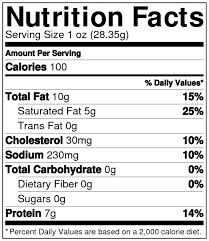What are we really looking for when we scope out a nutrition label at the grocery store? Are we after calories? Are protein, carb and fat totals or percentages most important? Does the ingredient list make a difference or should our focus simply be calories in vs. calories out? Let’s break it down and take a closer look!
Total Calories:
This lets you know how many total calories there are PER SERVING. Be sure to take a look at the serving size on the product you’re consuming, products will often boast ‘only 100 calories’ per serving all the while there are multiple servings per package!
Fat:
Fat is up next and while our society isn’t fearing fat like it used to it still seems to be highest on the priority list of a lot of label lookers. Fat contains 9 calories per gram so if an item has 10g of fat there are 90 calories coming from fat in that food.
Saturated and trans fats are listed on most items as well, we definitely don’t want to be eating foods with harmful trans fats however foods like eggs and coconuts contain healthy saturated fats we humans thrive on!
Cholesterol:
We don’t need to fear cholesterol in food nearly as much as the mainstream media would like us to. The liver produces cholesterol every single day and without it we would die, therefore it’s an EXTREMELY important substance in the body.
If we consume it in the form of food the liver automatically down regulates our endogenous (internal) production and if we avoid the stuff via low cholesterol foods the liver produces more…our bodies are so intelligent and savvy when it comes to cholesterol! For the purpose of this article this is a SUPER simplistic way to address cholesterol, I’ll be diving into it a lot deeper in the future.
Fun fact…shrimp is 'high' in cholesterol!
Sodium:
Sodium is next in line and while we don’t need to avoid the stuff like the plague we don’t want our intake going through the roof either. Most people seem to do pretty well on about 4-5 grams of sodium daily with the exception of folks with high blood pressure and other specific conditions.
Potassium:
Potassium is important but assuming we’re consuming plenty of veggies as well as moderate amounts of fruit we should be covered on the potassium front…don’t need to worry too much about this guy!
Carbohydrates:
CARBS…oh man are we carbphobic! While carbohydrate content is one of the more important things we want to look at on a nutrition label they’re not the be all end all.
Carbs contain 4 calories per gram so if a food has 20 grams of carbs it yields 80 calories from carbohydrate.
Fibre:
Fibre is a biggie but more so in relation to the carb content. The higher the food is in carbs the higher we want that fibre digit to be. Ya don’t want a food containing 50 grams of carbs with zero fibre…by default that’s probably not gonna be a great option because most likely it’ll be a highly refined/processed source!
Fibre slows digestion, makes us feel full and feeds beneficial bacteria in the gut among other awesome stuff so get it in!
Sugar:
This guy matters and again is tied in with the total carbohydrate amount. We don’t want massive amounts of sugar especially when our fibre is low, this is going to signify another low quality food source of carbohydrate more times than not! While sugar isn’t inherently evil, downing a bunch of it daily isn’t a great idea for body composition, health or well-being!
Protein:
This is another important one; protein is essential for our survival and actual means ‘the most important’ in Greek and Greeks are jacked so…yeah. While a lot of quality sources of protein don’t actually have nutrition labels on them (think fresh meat/seafood) frozen meat and fish of high value most often have labels.
Protein is like fibre in that it uses up a bunch of energy to digest, slows digestion of other macronutrients like carbs and is the most satiating macro a.k.a. it keeps ya nice and full!
Take Home…
Now let’s take a step back and look at the big picture, given all this info what are we really looking for on a nutrition label? The total calories matter, as do the protein, carb, fibre, sugar and fat totals.
Protein and fat are a little more straight forward while carbs are a tad bit trickier as we wanna take a closer look at the sugar and fibre content to go along with the carbs. We’re after less sugar and more fibre here!
So next time you hit the grocery store and pick up a product that has a nutrition label on it keep all this stuff in mind! Or even better yet when possible reach for foods that don’t even have a label on them i.e. the FRESH stuff!
